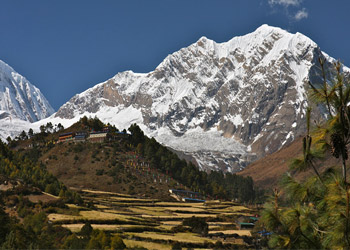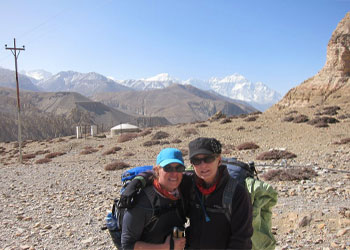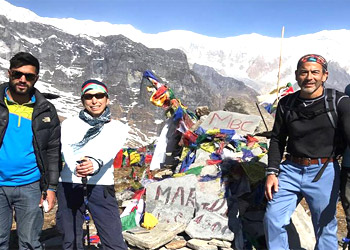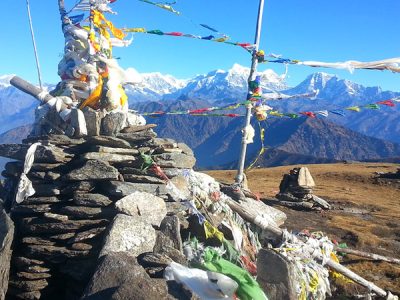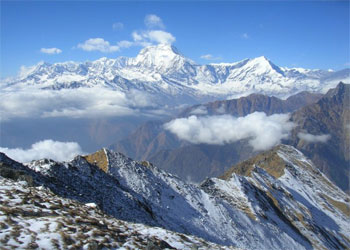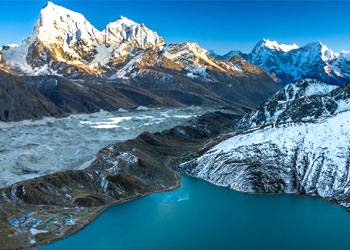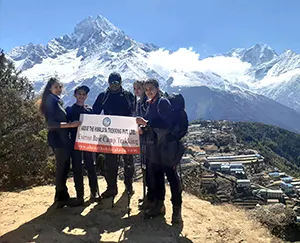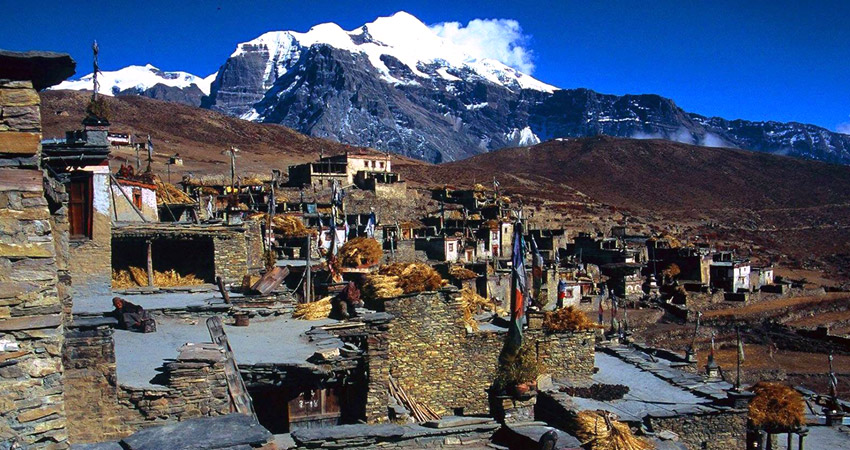
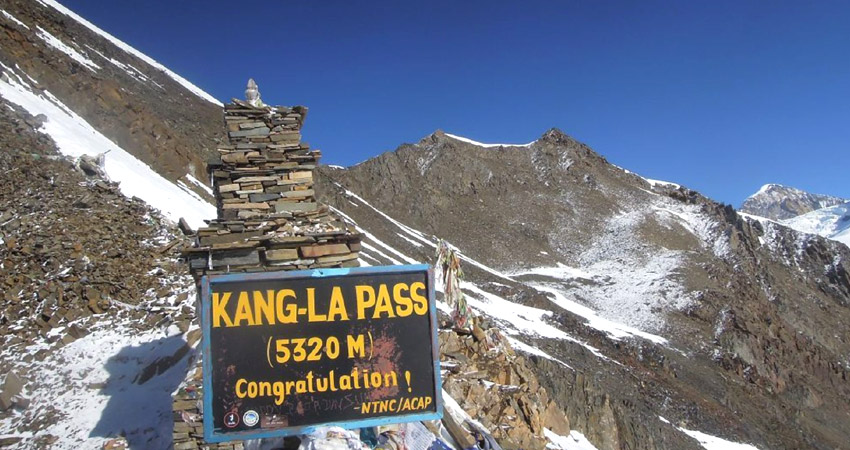
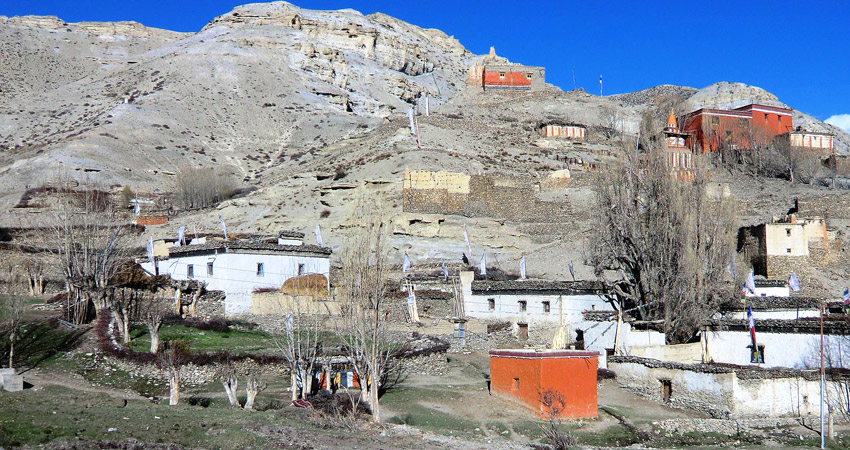
Small Group Departure Dates for 2026 and 2027
Note: We can run a trip for solo travelers, couples, friends, and family with children. Our private trips run daily. For small group travel, please check the dates below. If the dates below do not suit you, please email us or WhatsApp us at +9779851095800 to travel on your preferred dates.
Highlights of Nar phu valley trek
- Experience the mixed culture of Tibet-Nepal.
- Get a chance to visit one of the remote places in Nepal.
- Get astounding views of mountains like Annapurna II, Himlung Himal, Gangapurna, and Tilicho Peak.
- Explore the ancient architecture and local culture.
- Explore the untamed Nar and Phu Villages.
Overview of Nar Phu Valley Trek
Nar Phu Valley Trek is an exciting trek in meager tourist traffic. The Nar Phu Valley region lies in the northern region of Manang. It has remained untouched and uninfluenced by the modern world. This location contrasts with the popular, neighboring Annapurna Circuit.
The trail goes with the best picturesque medieval villages. We can see narrow gorges and herds of blue sheep along the way. The spectacular Cliffside trail over one of the region’s highest trekking passes. Very few trekkers visit this exotic land. It is still abundant in medieval Tibetan culture.
The culture has been intact for centuries. We can view dramatic mountain views and magnificent alpine scenery. This is the best-known tourist area on the Annapurna trekking routes.
There are a thousand reasons why people have always loved Nepal’s beauty. The Nar Phu Valley is one of the major ones. Its fantastic geography makes it irresistible for visitors.
You can gaze at the location for hours. It is even more commendable to wander around and explore new things in the region. The trek’s route overlaps and is communal with the Annapurna Circuit Trek.
As a result, it is located to the north of the beautiful Annapurna Himalayan Region. The country’s beauty is so vast and infinite that you can achieve even more for what you have sought. Getting to Nepal is easy and delightful. But returning without exploring a thing is quite tragic.
Nar Phu Valley short trek
We offer you a short trek to Nar village. After the pass, we can return to Kathmandu. During our hike, we can spend time in the colorful, traditional villages. We will also explore the high alpine valleys above Phu.
It includes the Himlung Base Camp and crossing Kang La Pass, and we will arrive at Ngwal. Afterward, if you want to shorten the trek, you can lead back into the Annapurna Circuit and to Kathmandu.
We put a short version of the Nar Phu Valley trek itinerary in this package. The trail goes through the dry, desert-like Tibetan Plateau if we do the more extended trek. This allows access to Muktinath and Jomsom trails. Muktinath is a pilgrimage center for thousands of Indian and Nepalese Hindu followers.
We will pass through the picturesque Manang and Mustang Valley. We will see the magnificent Kali Gandaki and Marsyangdi Rivers. You can also get close-up views of the Himalayas. The region has a variety of ecosystems, green paddy fields, and oak forests.
Thus, this trek is one of the most stunning in the world. After heading to Jomsom’s headquarters, we move north to Kagbeni. We trek along the riverside of Kali Gandaki. Thus, this trek is an excellent adventure and an add-on to a visit to the Manang region or the Manaslu trek.
Itinerary of Nar Phu Valley Trek
01
Day 01: Greetings at Kathmandu Airport
We will meet you at the Kathmandu International Airport and take you to your hotel, where you will stay for your Nar Phu Valley trek.
After you had time to settle in and freshen up after your long flight, we have a short meeting to check your equipment and discuss the Nar Phu Valley trek itinerary and other details. If you are arriving late today, we have an appointment the next day in the early morning for your Nar Phu Valley trek.
02
Day 02: Complimentry tour of Kathmandu city
After breakfast, we will leave for a day tour of Kathmandu. The tour covers the city’s central cultural heritage. Our English-speaking tour guide and private car with a driver will accompany you.
Our day tour takes you to Pashupatinath Temple and Swoyambhunath, which are ancient and primarily enlisted in UNESCO World Heritage sites.
You can also visit the biggest Buddhist Stupa at Boudhanath. You have time to explore the local area, have dinner, and prepare for tomorrow’s journey.
03
Day 03: Drive Kathmandu to Koto
Today, we drive to Koto. We will take a local bus to Besisahar from New bus park and take a local sharing jeep. The Nar Phu Valley trek starts in Dharapani. You can take a direct Jeep drive, which costs extra money. It will take about 10 hours to get there.
During our drive, we can view the river, local villages, and beautiful mountain scenery. A small mountain road passes by paddy fields and tiny Tibetan villages. Rhododendron forests are on the road to Koto; our Nar Phu Valley trek start point.
It is a small village inhabited by Gurung and other ethnic groups. Buddhist Tibetans influence their lifestyle. Stay overnight, Koto, in a small guest house.
04
Day 04: Koto trekking to Dharmashala
After breakfast, we will start our Nar Phu Valley trekking from here. The first part of the trail is on a steep and narrow path through the dense forest. The trail climbs above the river through silent cliffs, pines, and bamboo forests. It passes several scales of hand-swan timber camps and caves.
After crossing the Phu Khola, detour downstream. Downstream leads to a small but charming riverside hot spring. We walk under the waterfalls before arriving at the basic local homestay lodge at Dharmashala.
05
Day 05: Dharmashala trekking to Kayang
On our Nar Phu Valley trek, On arrival at Meta (3700m), This is a nonpermanent winter settlement of Nar. The next section of the trail is far more tortuous. Crossing a roller-coaster maze of glacial moraines will take most of the energy. We will find the white rocks, low shrubs, and juniper landscapes here.
Let’s enjoy the small trail of the Nar Phu Valley trek. We will see the scattered evergreens, delicate brick-red, and orange leafy bushes. They are crumbling shelves of flat slate and white, sandy trails. The ahead trail junction gives us a clear view of Nar Valley with the monastery and Chorten.
We arrive at the small settlement of Jhunam (3640m). We continue our trek to Chyakhu (3800), a Khampa settlement. Passing many Chortens, uphill and downhill, we finally arrive at the settlement of Kayang Valley. This place offers magnificent views of Pisang Peak, Annapurna II, Gyoji Kang, etc.
06
Day 06: Kayang trekking to Phu village
From Kayang, you swing into the dry, desert-like gorge of the Phu Khola. We inched along on a hair-raising trail carved out of the cliff face. We will work steeply down the Hill along the river bank and past the submarine rock with a small campsite.
You get the best view of unique, colorful Chortens with the canyonlands and gorges. They keep your eyes out for blue sheep grazing on the khaki Hill. We are walking along the hillside and to the Phupi Gyalgen Gate.
From here, we descend to the collection of Chorten beside the bridge. This ancient gate provides the first view of the three villages of Phu. It also contains an old “dzong” and the remains of the two forts, which are all now in ruins. Spend your night in the local tea house of our Nar Phu Valley trek.
07
Day 07: Phu village trekking to Nar
Today, Our Nar Phu Valley trek returns to Phu Gate Khyang, Chyarkha, and Jhunam to the junction where the trail branches right to Nar.
We are walking down to the eroded hoodoos, over sandy gullies connected by bridge-like platforms. Look for the ruined Zampa Cho Dzong (a dzong is a fort: zampa is Tibetan for the bridge).
Along the way, we’ll see some beautiful gorges and breathtaking scenery. You finally reach the Nar gates at the top of the hill and pass by yet another line of wonderfully painted bamboo-topped Chortens and a sizeable tiered Chorten. Stay overnight at camp at Nar village.
08
Day 08: Nar trekking to Kang La Phedi
Today, we start our Nar Phu Valley trek with quite a challenge climbing up from the main trail. It is about 1 hour long. We can see the best view of Mount Kang Garu Peak across the valley. The course goes through the grazing field with a small stream on the left.
The Nar Phu Valley trek trail leads through the village with a superb view of Pisang Peak to yak the grazing Alps. Traverse Yak pastures and descend to the head of the valley. Overnight at the Kangla Phedi.
09
Day 09: Kang La Phedi trekking to Kang La pass to Ngawal
The Kang La is not a steep pass, but it could be a long day if snow is on the pass or the altitude is taking its toll.
Today is the most challenging pass of this Nar Phu Valley trek, as we will cross the spectacular Kang La pass. This pass provides a magnificent view of Pisang Peak, Annapurna II, and Gangapurna. It also offers Tilicho Peak and Hongde Airport.
After crossing the pass, we descend to the Manang Valley—the picturesque landscape and scenery that passes Yak’s and sheep’s shelter. We arrive at Ngwal after the long day’s walk. Ngwal is a beautiful old village With prayer wheels and stunning architecture.
10
Day 10 : Ngawal Trekking down to chame
Walking down to Chame on our Nar Phu Valley trek is easy. Today, the terrain is flat and downhill over the Marshyangdi valley.
We get spectacular views of Annapurna II, Gangapurna, and Annapurna III. We also get the opinions of Gandharva Chuli and Pisang Peak in the background.
We pass many pine forests and buckwheat farming terraces. We pass through the beautiful small village of Chame.
It is the district headquarters of Manang. A small Hotspring is also on the cover of the Marshyangdi River. Stay overnight at Chame.
11
Day 11: Drive back to Kathmandu from Chame
After our Nar Phu Valley trek, we will drive back to Kathmandu today by local jeep to Besisahar. It is sharing a jeep with other local people who are coming down to Besisahar.
We have a lunch stop at Besisahar and then take a bus back to Kathmandu. It is quite a long journey, about 9 hours. To explore Nepal more, you can also go to Pokhara from Besisahar.
12
Day 12: Final Departure
After your Nar Phu Valley trek, we will drop you at the Kathmandu Airport. We wish you a happy journey, traditionally and culturally. We send a Nepalese goodbye with the hope of seeing you again.
Trip Extension
Suppose you have more time in Nepal after this trip. In that case, we can help you to extend your trip by running different treks in Nepal, tours in Bhutan and Tibet, Jungle safari tours at Chitwan, Bardia, and other National parks, Nepal luxury hotel booking, Rafting, Ultra-light flights, or any other travel-related services. You can get more information here.
Includes/Excludes
What's Included?
- Airport / Hotel / Airport transfers by private vehicle.
- Hotel accommodation in Kathmandu is on a twin-sharing basis, including breakfast.
- Guided Tour of Kathmandu City with an expert tour guide and private vehicle.
- The government license holder and experienced trekking guide—trained guides for Wilderness First Aid& altitude sickness.
- Porters (1 porter for two trekkers basis). Have their food, accommodation, salary, equipment, accidental insurance, clothing, and medicine.
- Twin-sharing Tea house/Lodges, Accommodation during the trekking.
- During the trek, daily Meals will be available from the Menu (breakfast, lunch, and dinner).
- Annapurna Conservation Area Trekking Permit.
- TIMS Trekking Permit (Trekking Information Management System) Card for the Annapurna Trek.
- Special permit for Nar Phu Valley trekking.
- Group medical supplies (first aid kit will be available).
- Above the Himalaya duffel bag. ( If you need anything, please let us know before you book the trip. Please remind us in our pre-meeting at our office). During the trek, you can choose daily meals from the Menu (breakfast, lunch, and dinner).
- Kathmandu to Besisahar transport by local bus. Besisahar to Dharapani transport by local shared jeep.
- Comprehensive pre-departure information and trip dossiers.
- Above the Himalaya Gifts (T-shirt for Gents & Pashmina shawl for Ladies, Trekking certificates).
- Welcome/Farewell Nepali Dinner in Kathmandu.
- All necessary paperwork, office Service charges, and all Government Taxes.
What's Excluded?
- Lunch and dinner in Kathmandu
- Nepal entry visa fee. You can get a Nepal visa upon arrival at the Airport.
- International Airfare/Airport tax, City tour Sightseeing entry fees.
- Alcoholic, hot and cold drinks, hot water, hot and cold showers.
- Personal expenses include laundry, telephone calls, sweets, snacks, beverages, bar bills, and camera battery charging.
- Travel Insurance (Essential). Should include emergency evacuation coverage while trekking up to 5500+ meters).
- Personal trekking gears
- Tips for tour/ trekking staff and driver
- Any other expenses which are not mentioned in the Price Include section.
Route Map & Altitude Chart
Nar Phu valley Trek Solo
Doing this trek solo is impossible as we need at least two people. We need to issue a special permit and must two people. The solo trek is possible by joining our group, but you must enter and exit Nar and Phu Valley together. You can do a solo tour with a guide and follow the group itinerary.
The solo adventure is quite expensive. If you are two people, it will cost you less. Our Solo trek offers an unforgettable experience. It provides the purest Himalayan environment, landscape, and unique culture. Don’t wait! Contact us for bookings. We will help you explore this fantastic part of Nepal at an excellent cost.
Nar Phu Valley trek cost
The Nar Phu Valley trek costs more than other regular trekking tours in Nepal. The area is remote and restricted, so we need a special permit, which costs USD 100 per week per person. You need to trek with a registered company and travel with a guide, making your package cost a little high. Our total board package cost for the Nar Phu Valley trek is USD 1490. On top of that, you need to consider extra costs. It includes the cost of your drinks, battery charging, and personal expenses.
Nar Phu Valley Trek equipment packing list
The trekking route is a difficult-to-level travel route. It would help if you had the proper equipment to succeed. You will sleep and eat in the tea house, so you must carry your belongings, which are enough for the cold. Below are some suggested items for the Nar Phu Valley trek route.
- Walking boots should be waterproof and have ankle support.
- Trainer or casual shoes you can use after a day trek.
- Hiking Shorts (3): Quick drying type, not cotton!
- Trekking pants (3): Zip them on/off at the knees to use them as shorts.
- Loose, casual trousers for trekking
- Thermal wear for colder areas
- Lightweight underwear – Capilene or other synthetic.
- Cotton pants or (loose jeans/khakis).
- T-shirts: Cotton for lower altitude walking. The synthetic is good above 2500m.
- Thermal Underwear: Synthetic polypropylene
- Waterproof Jacket. Quality waterproof clothing is essential for the Nar Phu Valley trek. We recommend a proofed nylon or Gore-Tex jacket.
- Fleece jacket or pullover.
- Fleece Wind-Stopper jacket (optional).
- Goretex or warm coat for winter trekking. Bring a down jacket.
- Women’s sports bras, Synthetic
- Strong rucksack or large holdall for porters
- Daysack to carry valuables such as passports, cash, cameras, and travel documents.
- Plastic bags or stuff sacks to store
- Plug adapter 2 round pin
- Trail Map/Guidebook
- Journal & Pen, Pencils, and small notebooks
- Extra contacts or glasses
- Quick-drying towel (medium-sized)
- Toothbrush/paste (biodegradable)
- Multipurpose soap/handwash
- Deodorants
- Nail clippers
- Face and body moisturizer
- Feminine hygiene products
- Small mirror
- Wet wipes
- Sanitizers
- Water purification tablets or iodine
- Refillable Water bottles
- Wool or fleece hat, or balaclava
- Hat or cap for sun protection while trekking
- Sunglasses or goggles
- Warm gloves
- Towel
- Sun lotion
- Lip balm
- Sunglasses protect from day sunlight.
- The sleeping bag’s rate is at -20 degrees Celcius. You can also get a sleeping bag liner.
- Some Extra pairs of T-shirts and also shorts.
- Trekking pole
- Camera
- Flashlight and battery
- First aid kit (with moleskin for blisters)
- Extra passport photos and photocopies of your passport
Accommodation
Accommodation during the Nar Phu Valley trek is a very basic lodge/ tea house trek. If we complete the tea house in the Annapurna circuit, it is much more fundamental here. You will sleep in a bare room with a bed, mattress, bed cover, and pillow.
It would help if you had your sleeping bag, and it would be better to have a liner, too. The lodge’s facilities are bare. There is no electricity in some places, but they have solar power in the dining room. You can charge your battery for cell phones and cameras at an extra cost.
Health and Fitness
The main things to the Nar Phu Valley trek in Nepal need your positive thinking. You must be able to walk 5/6 hours on the rocky trail. You can be fit for the Nar Phu Valley trek by doing small exercises in your home country before you arrive here.
The more stamina you build up, the more effortless it is to trek for Nar Phu Valley. You can do running, cycling, Zumba, or some yoga practices to boost your energy. You will walk 5 to 7 hours daily, so train your legs. The best exercise you can do at home is squats and lunges.
Enjoy the Kang La Pass
Kang La Pass is the famous trekking pass in our Nar Phu Valley trek. This pass is also a Classified hidden valley. The fantastic journey is at an altitude of 5,320 meters. It passes in the northern corner of the Annapurna region. If we combine Kang La Pass and Thorong Pass, it will take about two weeks of trekking. It is one of the most challenging adventure trekking trails in Nepal.
The Kang la Pass will provide the superb scenery of the Annapurna Himalayas range. It offers a dry, hidden valley, Tibetan culture fellows, and charming villages. The pass is the wealthiest Himalayan herbal medicine, finding lands. It is also famous for Yarsagumba summer plants and winter insects.
While visiting Kang La Pass, we will trek in Nar And Phu Village. They provide a beautiful panorama of Himlung Himal at 7,126 m and Saribung Peak at 6,345 meters. There are historical old Buddhist monasteries. You can learn about Lamas’s reincarnations in Buddhism (bodhisattva). You can visit the Phu Monastery, a hamlet untouched by modernity.
Trekking to the Kangla Pass is a more complicated and narrow trail than Thorong la Pass. But it is a beautiful Highlander View. We can get a stunning view of many Himalayas. It includes the Annapurna III 7,555 m, Gangapurna 7,455 m, and Tilicho 7,134 m.
We cannot miss the Manaslu at 8,156 m, Himlung at 7,126 m, and Saribung Peak at 6,345 meters. There are three principal passes in Nar Phu Valley. They are Teri La Pass, Saribung Passes via Upper Mustang, and Kang La Pass from Ngawel Manang.
After the Kang La pass, we will arrive at the Ngwal. If you continue the trek to Annapurna round rail, we will go to Manang village. It is also the beautiful, prominent trekker’s town of the Annapurna circuit trek. You can continue to Thorong La pass, the highest pass in Nepal; Thorong La is 5,416 m above sea level.
Trek Grade: Difficult
Nar Phu Valley trek is difficult to grade, with 5 to 7 hours of walking daily. One or two days are a little longer, and some are shorter. The trails vary in different places. The starting part is well-marked and wide.
The upper part must be more well-traveled, rockier underfoot, and steeper. We are making an acclimatization day in our challenging trek after trekking 3,4 days. The problematic tour goes up to 5500m in height.
This zone has less oxygen. Our bodies will start to notice. They will adjust to the reduced air pressure (and thus reduced oxygen availability). We ask that you have a good level of fitness and stamina. Are you comfortable going on multi-day walks in mountainous terrain in your country? Do you swim, cycle, run, or take a fitness class a couple of times a week?
If yes, then you should find this trek within your means. You don’t need to be an experienced trekker to enjoy this trip, but you should feel comfortable hiking in the mountains. The chances of altitude sickness are high on this trek, so you must trek, drink plenty of water, and carry enough warm clothing.
Trekking Dates: You can do the Nar Phu Valley trek on any date. The best time is Feb, March, April, May, June, September, October, November, and December for a group of 2 to 12 people. The rainy season is unsuitable for the trek. The views could be better, and sometimes landslides can happen.
Your trekking luggage: You will have one porter for two trekkers to carry your luggage. The maximum weight per trekker is 15 kg, as we never overload our porters. Yet, you only take your valuables in your backpack, including your sleeping bag and down jacket. We can leave other unnecessary items in our office or your hotel in Kathmandu or Pokhara.
Equipment Renting and Buying: We tell you to bring all your clothing and gear from home for your Nar Phu Valley trek. But in Kathmandu, there are many shops where you can buy and rent trek-related equipment.
Transportation on the trek
There are different means of transport for the Nar Phu Valley trek. Our trip starts and ends at Besisahar. We can take a local bus from Kathmandu or Pokhara, about a 5-—to 6-hour drive to Besisahar. You can also take a private jeep to Chame at an extra cost. From Besisahar, we can drive by a local sharing jeep to Chame. The jeeps are with other trekkers and local people.
For the return Nar Phu Valley trek, we can use the same means of transport to Kathmandu or Pokhara. From Pokhara to Kathmandu, you can take a 25-minute flight or a 6/7 hours drive by bus or private car. The primary way to get there is by driving. Above the Himalayas, we must get the best transport available for the travel period. We choose the means of transportation based on your package itinerary and budget.
Nar Phu Valley Trek group size
Please note that the Nar Phu Valley trek restricts visitors. So we need at least two people to run this trek. But, our group size is also small, from 2 people to 10. We always make a small group to reduce the environmental impact. It enables us to provide a more personal service. The largest group size on most of our treks/tours is 12, and the smallest group size is 2.
After the COVID-19 pandemic, we are making our Nar Phu Valley trekking group size a 10-person limit. This makes it easy to provide the best service and look after you, from your trekking guide and porter. So any number you have doesn’t matter; you can book your trip with us. We are happy to run the best holiday for you.
Trekking To Nar And Phu in Nepal
Nar Phu Valley Trek in Nepal nowadays is more accessible than in the past, so long as you follow the rules. All foreigners must hire a registered trekking agency. They must carry an entry permit to show at checkpoints ($90 in trekking season, $75 in the rainy off-season). An Annapurna Conservation Area permit is also required to trek.
We can do a simple tea house tour now so that you can hike with only a guide and porter without other supporting staff. First, we will enter the Manang district. We can take a jeep from Kathmandu or Pokhara to Koto, or you can trek via the old Annapurna circuit route. You can also take a charter flight or helicopter to Humde’s tiny airstrip. It is better to walk from Syange or Jagat to ensure proper acclimatization. Due to the motorable road, the trail shortens each year.
As the motor road advances farther north, the trek is getting shorter. We will start the low path into the Nar Phu Valley trek from Koto. We will follow the river trail through a scenic forest of mixed conifers and deciduous trees. We will see spectacular glimpses of the high peaks far overhead to Nar village.
While trekking in late Autumn or winter, be careful with the snow. The trail can become treacherous, with dangerous landslides in snow. We enjoy exploring cultural sites and side trails before getting back to Kathmandu.
Less visited restricted route.
This Nar Phu Valley trek is in a restricted region, and we need to make a special permit. Only a few travelers go on this trek. It starts with a one-day drive from Kathmandu to Syange. The industry can go further from where the trekking gets initialized. Trekking and hiking are also beneficial in the context of health.
Apart from this, the candidate gets to enjoy the proper forms of nature. As the path offers, trekkers of the Nar Phu Valley trek can have surreal views throughout the journey. The tour offers panoramic views of the mountains of the great Annapurna massif. It also provides the striking Nar Phu Valley itself. A single package has many highlights, yet people have so much uncertainty.
Thus, we recommend taking advantage of this rare chance to experience natural freedom. Local inhabitants of the region also have a lot more to express themselves to visitors. They have an amicable kind of hospitality. Their unique lifestyle conveys the tastes of Tibetan culture. You would love to interact with people around you. You notice how they approach visitors with their very welcoming attitude.
Nar Phu valley trek itinerary
The Nar Phu Valley trek itinerary starts from Syange. It follows the Popular short Annapurna trek, which also passes by the famous Thorong La pass. We create our trekking itinerary from Koto, where you will take them off the beaten track to Nar Phu Valley. If you are lucky, you can see the blue sheep and snow leopard, as they live here.
Nar Phu Valley Trek goes with remote villages, narrow canyons, and beautiful forests. We can view the fantastic rock formations, yaks, Gompas, and a warm, welcoming culture. The Nar Phu Valley trek itinerary has 300 native inhabitants. This depends on yak herding and the salt trade. The Phu village is the best place to live the authentic lifestyle of the local Bhote communities.
The government’s decision to open Nar Phu to visitors did not inspire confidence in the villagers, who continued their rural lifestyle. Annapurna Conservation Area Project (ACAP) recently extended its network to include Nar and Phu Valley. It is preparing a suitable tourism development plan for this undiscovered region.
Nar Phu Valley trek permit
Nar Phu Valley trek is in the Nepal-restricted trekking area, so we need a special permit to travel there. We need three different licenses: one is a special permit. Another is an Annapurna Conservations area permit.
This permit covers the trek following the Annapurna region route. And another permit is a TIMS card. The permit fees from September to November are USD 100 per week; if you travel from Dec to August, it is USD 75 +. We need to add ACAP and TIMS card permit fees.
We need an original passport, your photograph, and travel insurance. The insurance covers up to 5500m in height, including rescue and medical help. The fee is free for children under ten, but we must fulfill all the formalities. We will help you make a permit and make arrangements for yourself. You only need your photos, original passport, and insurance.
Nar Phu is Remote trek in Annapurna region
This remote region is also known as “The Forbidden Kingdom.” The Nar Phu Valley trek is the last standing remains of the ancient forbidden kingdom of Tibet. This region is also called “The Little Tibet”. It is one of the untouched and unspoiled regions from the outside world.
Trekking in this beautiful land unites high hills, passes, and remote towns. It also connects restricted canyons, ice valleys, and dazzling wilds. The trail passes by stunning rocky establishments. It offers views of yaks, gompas, and exceptional Himalayan societies. Since the route opened in 2003, only a few Westerners have explored these untouched towns.
Only a few have traveled over the 7000-meter hills encompassing this forbidden valley. We will do the Nar Phu Valley trek in the upper Manang Valley in The Nar and Phu Valley. It comprises the remote, untouched, and fascinating towns of the Tibetan Buddhist world. Buddhist pioneers worldwide travel to the Phu Valley to visit the famous Tashi Lha Khang.
It is a religious community, and they get gifts from Lama Karma Sonam Rinpoche. Alongside the vivid and ageless towns, travelers encounter Himlung base camp above Phu. After crossing the High Pass of Kangla, we arrived at Ngwal.
We can also combine both passes of Kang La, 5315 meters. They travel west over the Thorong La pass, 5416 meters, and down through the lower Mustang. We can visit Kagbeni’s famous monastery before making for Jomsom. From there, we can fly back to Pokhara Airport and Kathmandu International Airport.
Nar Phu Valley Tea House Trek
The tea house Nar Phu Valley Trek stays in a typical wooden and stone-made hut. Some buildings have a kitchen, dining hall, bedrooms, and bathroom. The local people of the Annapurna owns and manages the tea houses on the Nar Phu Valley Trek. They serve all the basic needs of the trekkers. A tea house may sound like a typical one serving tea/coffee.
However, the tea houses on the Nar Phu Valley trek serve food and accommodation and offer other amenities to trekkers in the Himalayas. After the expeditions flourished in the Annapurna region, tea houses began in the Nar Phu Valley region. Before that, all trekking in Nepal was camping, which was much more expensive than the tea house trek.
During the camping trek, the trekkers have to carry large tents. The trekker needs to take the necessary items for accommodation and food. There were more Nepali staff guides, cooks, Sherpa, and porters. The quality of tea houses, facilities, and services may depend on their elevation.
Lower-elevation tea houses offer more facilities, and new tea houses offer better rooms. Some tea houses in Koto, Besisahar, and Manang provide standard accommodation. They also offer international cuisine, beverages, and other amenities.
Nar Phu valley trek map
Our Narphu Valley trek route map starts from Koto, a full-day drive from Kathmandu. The official hiking winds from here combine the remote villages of Nar and Phu town. It will pass through narrow canyons, lovely forests, and remarkable rocks.
After the Kangla passes the trek route map, arrive at the Annapurna round trekking path. From Ngwal, we can trek down to Pisang or Chame and drive back to Kathmandu. Thus, the Nar Phu trek route map is among the most exciting trekking routes in Nepal’s less traveled and remote parts.
Nar Phu is the most remote part of the Manang District in Nepal. Three routes are mapped to the valley. The route from Nyesyang to Mustang is open from March. The local villagers of Nar-Phu use this route the most.
We need to cross more than 15 plank bridges over the Nar Phu Khola, which follows through the middle of the valley. There are two villages in the valley: Nar and Phu. The Phu village lies about 10 km from Nar. The population of these two villages is about 1000.
Phu village is in a corner of a small valley of streams called Lhodal, and Phu flows through the middle of the valley. One more significant Buddhist monastery of the Nyingma sect is in the center of the village. The other more significant Buddhist monastery, Tashillhakang, is across the Lhodal stream.
Most villagers migrate from Nar to a lower altitude in mid-December. They remain there until mid-February. But older people are one or two others from each household who stay in the village in winter.
Trekking Difficulty
Nar Phu Valley trek lies in the most remote part of the Manang District of Nepal. The hike is complex grading as we need to cross the Kang La pass on a narrow trail. The rest of the path is moderate and requires a trek of 12 -15 km and, one day, almost 20 km. Trek hours are roughly 6/7 hours each day.
To join the Annapurna round trek, you must cross 5,400 m in height. But our itinerary comes back after the Ngwal, so it is pretty straightforward. Furthermore, we will encounter many uphills and downhills on the trail, so do some tiny training before the trek.
When is the best time to visit?
The best time to trek to Nar Phu Valley is September to November, which has a clear sky and stunning mountain views. If you travel from March to May, seeing the blooming flowers along the trail is best. The best thing about this route is that we can also hike during the monsoon season, as it is in the rain shadow area.
The landscape is like Tibet, so there is little rain here. Most of the social festivals and local people’s marriages also happen now. Winter is freezing, and lots of snow, so there are better seasons to trek here.
Trekking in the winter
The winter months of Late December, January, and February are difficult. They are the coldest and driest months. However, they are suitable for Himalayan views and are worn in many layers. At this time of the year, there is little rain.
The skies in the hills and valleys are further from the high mountains and can be hazy from dust and pollution. The days are short, and the nights are long. Thus, you can start the trek early in the morning and be wise to fish late in the afternoon.
Temperatures can drop below freezing in higher places like pass and high altitudes. Even during the day, temperatures may not rise much above freezing. Snow covers most of the trail.
The snow that does fall doesn’t melt and can become stiff and icy. The snow can make the trek harder. You can carry a walking stick; plastic crampons make it easier on the high pass trail.
Accommodation on the Na Phu Valley trek
The room in the tea house of Nar Phu Valley Trek will have two beds on each side, separated by a wooden tea table. Taking your sleeping bag would help. But there will be facilities for a pillow, bed sheet, coverlet, or duvet. Our Nar Phu Valley trek package offers you a twin-bedded room.
The single room facilities are available in some places depending on their availability. It is easier to get a single room during off-trekking seasons. The guest houses are fewer. No options are left due to the more trekkers in the tea houses.
Nar Phu Valley trekking guide and staff
Your trekking guide for the Nar Phu Valley trek speaks fluent English. We also have guides who speak more languages (French, German, Spanish, and Japanese. They will always look after your safety and maintain your health and security. They will also look after hygiene before doing anything else. On the Nar Phu Valley tea house trek, our guide will find you the best and cleanest guest houses for your comfort.
Washing And Toilet Facilities in Nar Phu Valley Trek
Indeed, most teahouses and accommodation plans offer hot shower services, while some charge extra. However, at times, some do not even have the facility. Hence, carrying wet wipes and towels to clean your body and face dramatically helps.
If you are provided with a hot shower facility, only a few accommodations have it in the form of a shower, while most offer you hot water in a bucket. Solar energy shower facilities are available in tea houses, while those without them provide hot water after boiling it in firewood.
Furthermore, toilet services in the higher regions are typically Asian-style, and you will need to squat down. Likewise, the water for cleaning after using the toilet is often in a bucket, and cleanliness varies widely from place to place.
It is wise to carry a bar of soap for hand washing. Also, most accommodations do not have an attached washroom and are often outside the room.
Travel Insurance
Before embarking on this journey with us, we advise you to have travel insurance. You must ensure it covers all your activities as you apply for it. Since we do not offer this service, you can use it from your home country.
You should give detailed information on your travel so that they will ensure your whole package. Having done this, in case of any unforeseen circumstances, it will cover your emergency evacuation, injuries, lost items, and medical ailments.
Tips
You can always tip guides, porters, or locals if you want to thank them for helping you. The tipping culture in Nepal is quite common and appreciated. The tips are not mandatory, but they might sometimes be expected from you.
Similarly, if you ever enter monasteries during the trip, you are expected to give a small amount as an offering or donation. Later, all the amount from people is used to renovate the infrastructure.
Reviews on Nar Phu Valley Trek
![]()
![]()
![]()
![]()
![]()
Based on 380+ Reviews

Christina Zinner
Austria
Perfect Nar Phu Valley Trek
The 12-day trek from arrival to Departure to Nar Phu Valley trek was superb. The company did a great job with their services.
The stunning mountain view and great weather welcomed us. Our guide, Sitaram, was the best and very helpful and cared for our needs. Transporting a private Jeep is more comfortable than the local Jeep or bus.
Thank you, Above The Himalayas, for everything.
Christina Zinner

Mike Walden
USA
Thank you Above The Himalaya for the Nar Phu Valley Trek
We have booked this Nar Phu Valley trek with Above The Himalaya Trekking. The views were excellent. The area needed to be more explored. The people of this region were very warm-hearted and kind.
They greeted us along the trail with warm gestures of kindness. We enjoyed this trek as the area is still virgin. We had a great guide, Mr. Basu, who specializes in this region. He helped us know the local culture and took us to exciting places.
The people here are Buddhist, and we saw many monuments of stupas and gumba’s along the way. We can explore this region’s unique culture, nature, people, traditions, and history. Thank you, Above The Himalayas, for the best trip.
Mike Walden

Emma Hughes
USA
Best time at Nar phu valley trekking
We had the best time at Nar Phu Valley trekking. The trail is so unique and unspoiled. We have not met any tourists along the route. The guest house is basic but fulfills our needs.
Our guide and porter helped us with all our needs. Thank you, Puru and Above the Himalaya trekking, for a fantastic journey. We will be back again and use your guy’s services.
Emma Hughes
Book with Confidence
- Flexible bookings and easy trip date changes
- Personalized service and customized group sizes
- Safe travels with owner-operated services and highly experienced guides
- Best price guarantee for the most value for your money
- Secure & easy online booking
Your Trek Leader
 Enjoy Himalayan scenery with the help of Nepal’s best guides with Government license holders and got training in first-aid, our Trip Leaders, know where you’ll find the best photos, most fascinating wildlife, and the best stream crossings.
Enjoy Himalayan scenery with the help of Nepal’s best guides with Government license holders and got training in first-aid, our Trip Leaders, know where you’ll find the best photos, most fascinating wildlife, and the best stream crossings.
 Have Questions?
Have Questions?
Talk to Expert
Meet Mr. Purushotam Timalsena (Puru), Nepal's best trek and tour organizer, who has been working in the Himalayas for more than 24 years.
WhatsApp/Viber +977 98510 95 800





